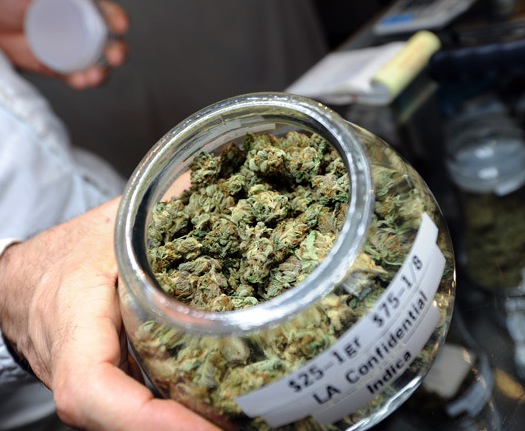On a warm summer day in Chicago at the International Cannabinoid Research Conference, hundreds of marijuana researchers were giggling. It wasn’t the groundbreaking research they’d just heard—proving the ability of THC, one of the active ingredients in marijuana, to stave off HIV (or RIV in monkeys)—that did it. Nor was it the author of the study, Dr. Patricia E. Morina, who had them laughing. It was the rogue researcher daring enough to taint the victory with a harsh dose of reality: “What’s next, testing this on humans?”
As the laughter subsided and the gravity of Dr. Molina’s results sank in, reality did too. THC is one of 500 active ingredients in marijuana. And marijuana, despite many studies proving its medical value, is sill classified by the government as a Schedule I Substance. In the face of mounting evidence that it is beneficial in treating diseases ranging from Alzheimer’s and Multiple Sclerosis, it remains a controlled substance. The joke wasn’t funny so much as painfully true: proving that an illegal drug can stop a deadly disease in humans, without testing it on them, is impossible. This bleak truth renders Dr. Molina’s discovery, at this point, futile. She’s found a key to a door that hasn’t been built.
When the journal Aids Research and Human Retroviruses published Dr. Molina’s story this week—more than three years after the study was completed—it was followed by a small amount of buzz. But it was largely overlooked by the mainstream media—perhaps because THC is already well known for treating HIV’s “wasting” symptoms, like nausea and loss of appetite. For those well-versed in the medical marijuana community, however, the results are too powerful to ignore. Amanda Reiman, California policy manager for the Drug Policy Alliance was at the conference in 2011 when Dr. Molina presented her results. “It was groundbreaking. Everyone was in awe,” she tells The Daily Beast.
The study itself was fairly simple. For 17 months, Dr. Molina and her team at Louisiana State University administered a high concentration of THC to 4-to-6-year-old male rhesus monkeys who were RIV-positive (a virus in chimps similar to HIV), twice daily. An examination of the tissue in their intestines before and after the chronic THC exposure revealed dramatic decreases in immune tissue damage in the stomach and a significant increase in the numbers of normal cells.
Mirroring other studies that link marijuana to HIV, the study illustrates how THC works by targeting so-called “CB2” receptors in the brain. One of two known cannabinoid receptors activated by cannabinoids (terpenophenolic compounds present in Cannabis), the CB2 receptors manifest in cells connected with the immune system, such as the gastrointestinal tract and the spleen. Unlike CB1 receptors, which respond to the psychoactive qualities of THC (producing a feeling of “high”), CB2 receptors react to the therapeutic aspects of THC—for example, reducing swelling and relieving pain.
The changes that THC produces in the gut a process formally known as “microbial translocation,” isn’t as complicated as it sounds. During HIV infection, one of the earliest effects is that the virus spreads rapidly throughout the body and kills a significant part of cells in the gut and intestine. This activity damages the gut in a way that allows the HIV to leak through the cell wall of the intestines and into the bloodstream.
When THC is introduced into this environment, it activates the CB2 receptors in the intestines to build new, healthy bacterial cells that block the virus from leaking through the cell walls. In other words, the body works hard to keep bad stuff in the intestines and the good stuff out. Put another way: HIV kills the cells that protect the walls— THC brings them back. Reducing the amount of the virus in the lower intestines could then help keep uninfected people uninfected.
The results of Molina’s study were bigger than even she imagined. “When we started the study, we thought [THC] was going to increase viral load [the amount of the HIV virus that is present in the gut],” Dr. Molina told Leaf Science. It did the opposite. “It adds to the picture and it builds a little bit more information around the potential mechanisms that might be playing a role in the modulation of the infection,” Molina said.
While some are praising Dr. Molina’s work, others take issue with classifying it as a potential way to decrease the spread of HIV. Dr. Leslie Walker, chief of the Division of Adolescent Medicine at Seattle Children’s Hospital, disagrees with the study for a variety of reasons. “One would need to actually read the study and then help them see animal model as a beginning; one cannot make the leap to preventing HIV from this type of study,” she wrote in an email to The Daily Beast, adding: “Many things can fight infection in the stomach lining that may have no impact on an overall infection.”
Dr. Kevin Sabet, Director of ProjectSAM an anti-marijuana group co-founded with Patrick Kennedy, feels equally as strong. “This study looked at THC—not marijuana—and they should not confuse the two issues,” he told The Daily Beast. “This is not about marijuana—and any characterization as such is flawed…It would be like saying people should smoke opium because Morphine might help with X condition.” Government researchers are only a bit more enthusiastic. Dr. Carl Dieffenbach, Director of the Division of AIDS (DAIDS) of the National Institute of Allergy and Infectious Diseases (NIAID), had just read the study when we talked. “In my mind, I don’t see its relevance to the human condition,” he said. “I’m speaking as a taxpayer and a scientist.”
Part of the issue, now that a study such as this one could technically be performed in Colorado or Washington, is the stopgap on government funding. Still, Dr. Dieffenbach, who has dedicated his life to researching ways to prevent, diagnose, and treat HIV doesn’t feel strongly about it being tested on humans. But what if it did? Should he be allowed to test it at the point, despite its illicit nature? Our colorful conversation is interrupted by an awkward response: silence. “I don’t have an opinion on that,” he says moments later.
It’s views like these that infuriate those in the drug policy world, like Amanda Reiman. “Look at the amount of research that started with animals and moved to humans. That’s the normal progression,” she says in response to critiques on the results stemming from monkeys alone. “What’s the alternative? We just give up? We’ll just never study it in humans, so we’ll never know?” she adds with audible frustration. “I’m sure the hundreds of thousands of people living with HIV would disagree with that plan. I think they’d say that ‘hey, if it worked on a monkey, let’s try it.” The main issue Reiman highlights isn’t a lack of research—but a lack of government funding. The National Institute on Drug Abuse (NIDA) handles all of the grants to perform research with cannabis. “There is no place in our scientific protocol to investigate the benefits of illicit substances—including cannabis,” she says.
The process of obtaining research-grade marijuana is no walk in the park. Any independent U.S. group wanting to do research must first get approval from a special Department of Health and Human Services committee who reviews the project. A spokesperson for NIDA told The Daily Beast that independently-funded requests are “extremely rare.” Since 2001, only 18 requests have been submitted to the HHS review committee—15 of which have been approved. Additional approval from the Drug Enforcement Administration is required before the request makes it to NIDA’s drug supply program. Beyond being illegal, the spokesperson raises other issues with testing THC on human subjects. “It is difficult to do human research on any kind of potentially addictive drug,” the spokesperson said. “It is not ethical to give these drugs to naïve subjects, so we are often limited in the kind of clinical research we can do.”
Mason Tvert, Director of Communications for the Marijuana Policy Project (MPP), says Dr. Morina’s research is a small step forward in a race that’s already being run. “There is a growing body of evidence demonstrating the efficacy of marijuana in the treatment of a variety of medical conditions,” he tells The Daily Beast. “This is not the first time researchers have identified the benefits marijuana can provide to people with HIV.” He’s right. The findings stand on the shoulders of a great deal of research linking marijuana and HIV. In a 1999 study (PDF) by The Institute of Medicine, researchers called cannabis a “promising treatment” for “nausea, appetite loss, pain, and anxiety.” According to data from the Centers for Disease Control and Prevention, approximately 1.1 million Americans are living with HIV—200,000 of whom are unaware of it. Each year an estimated 50,000 are diagnosed and while treatment is available, the fight for a cure rages on. In 2011 alone, 636,048 people died from AIDS.
In the wake of such studies, marijuana has become a fixture in the world of HIV treatment, something that Tvert hopes will continue. “Marijuana’s ability to stimulate appetite has proven to be a life-saver for patients suffering from HIV wasting syndrome, which can result in dangerous levels of weight loss,” Tvert says. “Research like this will continue to come out, and it is only a matter of time before more states and our federal government stop blocking HIV patients from accessing this valuable medicine. Unfortunately, there are still many people who are very sick and do not have time to wait.”
News Moderator – The General @ 420 MAGAZINE ®
Source: Thedailybeast.com
Author: Abby Haglage
Contact: Contact Us – The Daily Beast
Website: Weed Could Block HIV’s Spread. No, Seriously. – The Daily Beast















